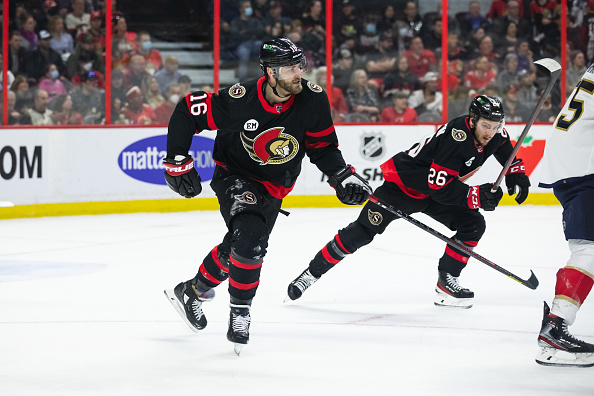NHL player development seems to always result in more questions than answers. How likely is it for a top pick to pan out? What makes a player a “steal”? Last Word is answering all these questions on our NHL Player Development series. This week’s piece involves draft picks in the back half of the first round and how they were used early in their careers.
NHL Player Development Of First-Round Picks
In the span of 2005 through 2015, there were 84 total selections made between 16th overall and 30th overall on forwards playing in North America. Looking at all 84 forwards, they were split into different categories. Those categories were “Forwards Deemed NHL-Ready and Brought In Immediately When Ready,” “Forwards Near NHL-Ready and Brought In Immediately When Near-Ready,” “Forwards Rushed Slightly,” “Forwards Rushed,” “Forwards Forced,” “A Little Patience,” “Patience,” and “Too Much Patience.”
There were 13 forwards who fell into the third category on the list. Of those 13 players, two made their NHL impacts in their DY+5 or later season. Those players are Jim O’Brien, Joe Colborne, and Austin Watson. In this piece, let’s look at Watson.
Austin Watson
Austin Watson, drafted 18th overall in the 2010 NHL draft by the Nashville Predators, came out of the OHL’s Peterborough Petes organization. However, in his DY-1 season, he played for the Windsor Spitfires. In 63 games, he scored 10 goals and 19 assists for 29 points, for 0.46 points per game. That ranked 69th out of the 84 aforementioned forwards in DY-1 production. The following season, he would be traded mid-way through to the Petes. In total, he played 52 games and scored 20 goals and 34 assists for 54 points, for 1.039 points per game. That ranked 55th out of those same 84 forwards in DY production. Austin Watson, after being drafted, would spend another two seasons in the OHL and three in the AHL before making the jump to the NHL.
In his DY+1 season, Watson would score 34 goals and assists for 68 points in 68 games for exactly one point per game. That ranked 48th out of the 82 forwards still outside the NHL in DY+1 production. The following season, he would be traded mid-way through to the London Knights. In total, he played 61 games and scored 25 goals and 43 assists for 68 points, for 1.115 points per game. That ranked 25th out of the 70 forwards still outside the NHL in DY+2 production.
AHL Time For Austin Watson
Coming over to the AHL the following season, Watson scored 20 goals 17 assists for 37 points in 72 games, for 0.514 points per game. That ranked 25th out of 46 forwards still outside the NHL in DY+3 production. In his second AHL season, he played 76 games and scored 22 goals and 24 assists for 46 points, for 0.605 points per game. That ranked 10th out of the 30 forwards still outside the NHL in DY+4 production. Finally, in his third AHL season, Watson scored 26 goals and 18 assists for 44 points in another 76 games, for 0.579 points per game. That ranked 10th among the 23 forwards still outside the NHL in DY+5 production. After a long road, Watson would get his first true shot at an NHL role the next season, in 2015-16.
How Watson Was Used
Watson would play exclusively in the NHL in the 2015-16 season. Playing 57 games and averaging exactly 10:00 time on ice per game. In that relatively small role, Watson would score just three goals and seven assists for 10 points. Despite the very little production offensively, Watson’s analytics were quite solid. His even-strength offence goals above replacement (EVO) was an okay 1.7 score. Meanwhile, his even-strength defence goals above replacement (EVD) was a really good 2.6 score for a rookie. With his modest even-strength impacts, Watson’s wins above replacement (WAR) were a decent 0.7, while his goals above replacement (GAR) were a decent 3.6.
In his second season, Watson would have a small three-game stint in the AHL, scoring one goal. At the NHL level, he would play 77 games and average 12:26 per game. In that slightly larger role, he scored five goals and 12 assists for 17 points. Watson’s EVD would remain exactly the same as year one (2.6). However, every other analytic would drop. His EVO (0.3) would fall quite a bit, and that led to his WAR (0.6) and GAR (3.0) falling slightly.
Watson’s Year Three See’s More Regression
Watson’s third season would see similar production and regression of analytics. He played 76 games this time and averaged 12:20 per game, a very similar role from year two. With that, he scored 14 goals and 19 points, another modest point total. His EVO (-1.1) continued to regress, and his EVD (2.3) dropped slightly as well. With his even-strength impact showing regression, Watson’s WAR (0.4) and GAR (2.3) also continued their regression.
After that season in 2017-18, he would play 90 more games with the Predators over the course of the next two seasons. In that time, he scored 13 goals and 17 assists for 30 points. In 2020-21, Watson joined the Ottawa Senators, where he remains today. Over the last two seasons with the Senators, he combined for 13 goals and 13 assists for 26 points in 101 games. Austin Watson’s player development was not the best. In his rookie year, he showed some strong promise as a two-way forward. It looked as though he could have carved out a decent role and career. Instead, he was held tight in a bottom-six role and settled into that role. He never grew beyond that point, and likely never will take that next leap.
Junior league stats via Elite Prospects, NHL stats via Hockey Reference, NHL analytics via Evolving Hockey
Main Photo:
Embed from Getty Images






